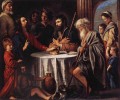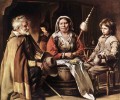Artists
Louis Le Nain
- Country:
- France
- Birth year:
- 1593
- Death year:
- 1648
Nothing is known about the education of Louis Le Nain (1593 Laon-1648 Paris), but he arrived in Paris around 1630 with his two brothers, Antonine (1588-1648) and Mathieu (1607-1677), where the three opened a workshop together. It is difficult to distinguish the brothers' paintings from each other because they often worked on the same canvas as a collaborative team. As the most talented of the brothers, Louis Le Nain was soon designated "the Roman" in reference to a probable, but undocumented, period in Rome. In 1648 he was accepted into the Academie Royale de Peinture et Sculpture. In additon to a few history paintings, the brothers concentrated mainly on scenes of simple peasant life, which present the opposite pose to the courtly painting of the time. Other works of theirs include St. Michael Dedicating his Weapons to the Virgin, c. 1633-1640, St. Pierre, Nevers; Return from the Hay Harvest, 1641, Musee du Louvre, Paris; and Venus in the Smithy of Vulcan, 1641, Musee St-Denis, Reims.











